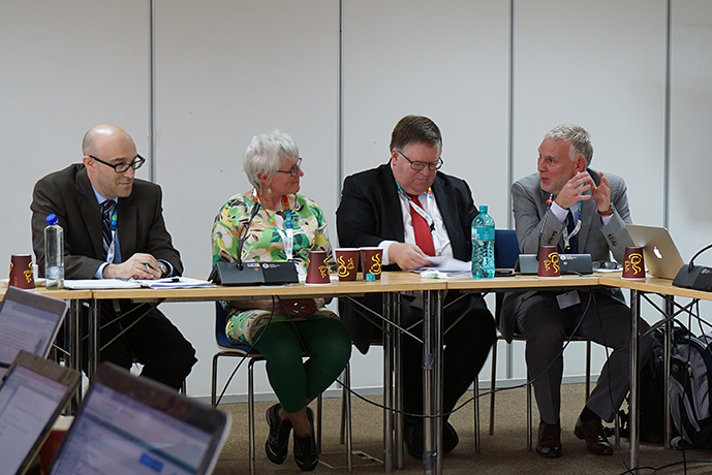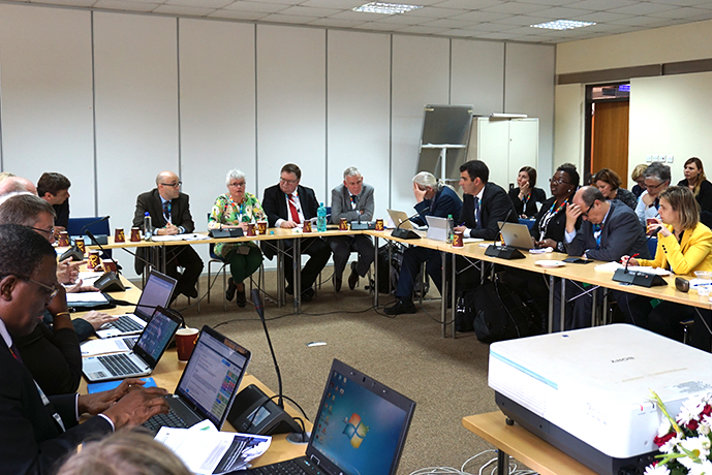How the world can achieve both fossil-free societies and a non-toxic environment
Published
The world is facing major challenges in the area of climate and the environment. The Paris climate agreement is aimed at keeping the rise in global temperature below 1.5 degrees Celsius, and the countries of the world have also agreed on 17 global goals for sustainable development, to be achieved by 2030. How do we ensure that the measures we take to achieve one goal do not make it more difficult to achieve one of the other goals? This was at the core of the discussions during the seminar Sweden arranged in cooperation with the United States at the UN Environment Assembly, UNEA2, in Nairobi.
The countries of the world have set ambitious goals in the area of climate and the environment. Several of the goals are also interconnected, and efforts to achieve one goal may also help to achieve several others. Sweden has previously drawn attention to links between climate change and marine and water issues. At UNEA2, Sweden and the United States took the initiative to begin investigating a new area: the links between climate change and the treatment of chemicals and waste. The seminar brought together high-level representatives of governments, academia, business and civil society.
One concrete example of how chemicals and the climate are interconnected is mercury. In 2013, the Minamata Convention was created to reduce emissions of and exposure to mercury throughout the world. The effects of climate change – such as increased precipitation levels – can lead to more mercury being released from the ground and leaking into lakes and seas. This goes completely against the important efforts that countries are now taking to reduce levels of mercury.
Several examples of areas in which chemicals and climate policy meet were raised during the seminar. Daniel Wolfish from Canada's Ministry of the Environment and Climate Change gave the example that as the Arctic ice melts, hazardous substances are being released that have been bound up in the ice for many years. When released, they spread to drinking water and into the natural environment and affect people's opportunities to eat fish from the seas or game meat. He also stressed the importance of studying the area from a gender equality perspective in particular – how women are affected by climate change, chemicals and waste.
The challenges facing the chemicals industry were mentioned by several people. Jochen Flasbarth, State Secretary at the German Federal Ministry for the Environment, Nature Conservation, Building and Nuclear Safety, said that with the rapid technological developments now taking place we must ensure that new technologies do not have a negative impact on the environment:
"We would be making a big mistake if we just focus on the climate goals and ignore the fact that we also have to achieve the other environmental objectives, in the area of chemicals for example. We must ensure that the new technologies we are looking at to reduce climate emissions do not have a negative impact on the environment at the other end," said Mr Flasbarth.
"Research, business, authorities and governments must work together if we are to succeed in linking chemicals and the climate. Governments around the world must show political leadership and we also need to devise policies for innovation that see the connections between the climate and chemicals," said Greg Skelton from the International Council of Chemical Associations.
The seminar at UNEA2 was an initial attempt at a discussion on how the climate and chemicals are interconnected, what the risks and opportunities are between them, and how work can be advanced. The current global goals for chemicals apply until 2020. Before then, the countries of the world are due to negotiate and adopt new global goals for chemicals for the period up to 2030. This process will be important in the work to investigate the connections between chemicals and the climate.
"Investments are now needed to investigate in more detail the links between chemicals and the climate, otherwise there is a risk that in dealing with one problem, we create another. We must ensure that the chemical goals we set for 2030 can also help us achieve the climate agreement's goals on reduced climate emissions. Similarly, we must ensure that countries' efforts to implement the climate agreement do not make it more difficult to conduct work aimed at limiting the occurrence of hazardous chemicals," says State Secretary Gunvor G. Ericson.
The United Nations Environment Programme (UNEP), which is hosting the ongoing meeting in Nairobi, thanked the United States and Sweden for their initiative and commented continuing efforts as follows:
"The challenge will now be to see how, in our practical work, we can begin to integrate these ideas into our organisations. This is a new approach that is also symbolised by the global goals for sustainable development – thinking broadly and holistically when we tackle challenges," said Achim Halpaap, Head of UNEP's Chemical and Waste Branch.
Many of the participants showed a great deal of interest in continuing the discussion and investigating the links between the climate and chemicals – and urged Sweden and the United States to continue initiating dialogues. Moderator Daniel Reifsnyder, the United States' Deputy Assistant Secretary for Environment, summed up the seminar in four points:
- All countries and actors must take into account various perspectives when working towards the goals.
- The world needs to map out the points of contact between the climate and chemicals.
- It is problematic that many organisations work on issues in isolation; more holistic working methods are needed.
- The business sector has many of the solutions and more cooperation is needed to deal with the challenges that we see in this area.



 X
X